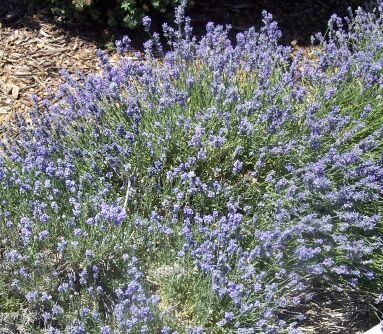Every summer my family takes a trip to Bear Lake on the Utah/Idaho border shortly after the Fourth of July, and we drive past a lavender farm about half an hour south of Provo. If I look out to my left, I see acre after acre of fragrant purple fields. It’s that time of year again, and lavender plants are popping into bloom. Mine have begun their annual show and I’m making plans for those tiny purple flowers.
Lavender is a woody perennial that will grow in almost any kind of soil, as long as it is drains well, and it can handle anything from high-moisture areas to Xeriscaping. It prefers full sun and though one source I read said it only handles temperatures to about 0 F or -15 C, It grows fine in my area, where it often gets below zero for part of the winter.
I’ve been told if you trim back the bush after the blooms are finished for the season, you can often get another set of blooms later in the summer, and some varieties actually bloom for most of the summer. There are many varieties and each has slightly different properties, so check and see what you can learn about strains available in your area. The plants live up to ten years and can be started by seed (a method that is somewhat unreliable, but possible) or by taking cuttings in July or August and rooting them.
These plants do best if you baby them in a green house or inside over the winter and plant them out in the spring. Lavender has been used for centuries, not only in sachets and potpourri mixes, but for medicinal purposes, and even for eating.
There are many medical applications for lavender oil: it can be rubbed on the temples to cure headaches; it has been used as a psychological calming agent to help people sleep or relax; it is a powerful antidote to some snake venoms; it is so antibacterial, it will kill typhoid, diphtheria, and strep germs, among many others.
The essential oils are also used to treat sunburns, and as an insect repellent. The leaves, petals, and flowering tips can be used raw in salads (in small quantities as they do have a strong flavor), and can be used as flavoring in many dishes from ice cream, to cakes, lemonades, and in meat marinades and vinegars among other uses.
You can use the plant, either fresh or dried to make herbal teas, too. I made a lavender-flavored custard for Sunday night dessert, and everyone liked it. Check on the web for lavender recipes—there are hundred of them out there.

such a nice blog.
berto xxx
I love lavender and have been wanting to put some around our house. Thanks for the post and great tips!
Heather,
Oh, I’m so glad you’ve highlighted lavender this time. It’s a wonderful plant.
Several years ago when I had it blooming in my yard, I dried the flowers and leaves, put them into an envelope (a cloth bag would be nicer, but an envelope is faster and easier) and slid the envelope under my pillow when I made the bed in the morning. Then I’d pull the envelope out at night and set it by the bed. It always made for such a relaxing fragrance in the room and on my pillow.
Heather,
I love all the medicinal ideas here! I hope you don’t mind if I use some of your ideas in my book.
Also, I’d LOVE to have some of those recipes you mentioned.
I really want to plant some lavender in my yard, do you think it’s too late in the season?
Good blog.